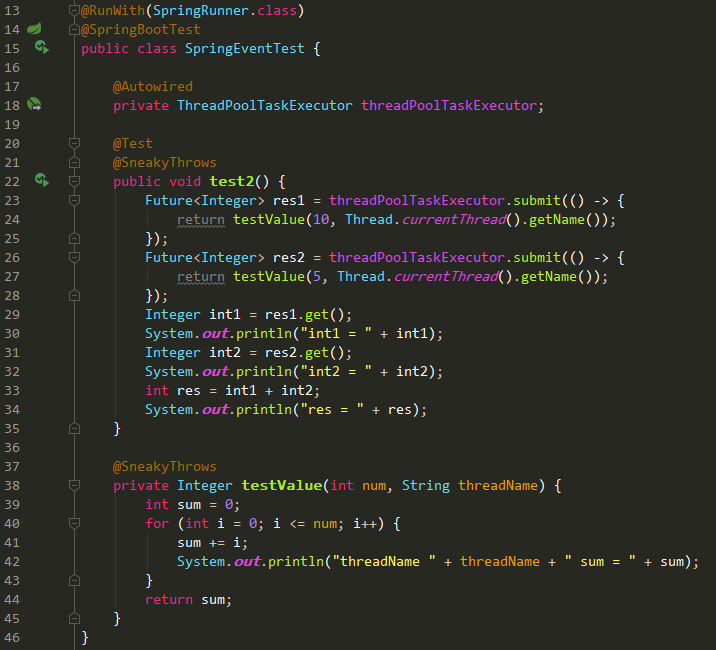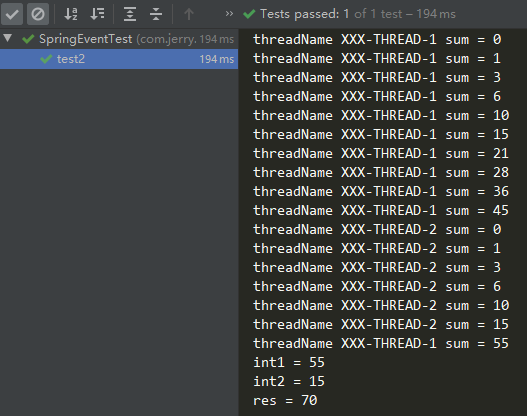异步处理器Service
1
2
3
4
5
6
7
8
9
10
11
12
13
14
15
16
17
18
19
20
21
22
23
24
25
26
27
28
29
30
31
32
33
34
35
36
37
38
39
40
41
| import lombok.extern.slf4j.Slf4j;
import org.apache.commons.lang3.concurrent.BasicThreadFactory;
import org.apache.commons.lang3.exception.ExceptionUtils;
import org.springframework.stereotype.Service;
import java.util.concurrent.*;
@Slf4j
@Service
public class AsyncHandlerService {
public final static int THREAD_MAX_NUM = 60;
private final ExecutorService executorService = new ThreadPoolExecutor(
THREAD_MAX_NUM / 2,
THREAD_MAX_NUM,
10,
TimeUnit.SECONDS,
new LinkedBlockingQueue<>(10240),
new BasicThreadFactory.Builder().namingPattern("AsyncHandlerService-thread-%d").daemon(true).build()
);
public void submit(Runnable runnable) {
Callable<Integer> callable = () -> {
runnable.run();
return 1;
};
Future<?> future = executorService.submit(callable);
executorService.submit(() -> {
try {
future.get();
} catch (Throwable throwable) {
log.error("执行异步任务出错{}", ExceptionUtils.getRootCauseMessage(throwable), throwable);
}
});
}
}
|
ThreadPoolExecutor
核心参数详解: https://juejin.cn/post/6987576686472593415
1
2
3
4
5
6
7
8
9
10
11
12
13
14
15
16
17
18
19
20
21
22
23
24
25
26
27
28
29
30
31
32
33
34
35
36
37
38
39
40
| @Configuration
@Slf4j
public class ThreadPoolConfig {
@Bean(value = "executorService")
public ThreadPoolExecutor threadPoolExecutor() {
int cpus = Runtime.getRuntime().availableProcessors();
return new ThreadPoolExecutor(
cpus * 5,
cpus * 10,
30L,
TimeUnit.SECONDS,
new LinkedBlockingQueue<>(100),
new CustomThreadFactory(),
new CommAbortPolicy()
);
}
static class CommAbortPolicy implements RejectedExecutionHandler {
@Override
public void rejectedExecution(Runnable r, ThreadPoolExecutor executor) {
String message = executor.toString();
log.error("线程池已满,无法继续处理任务:{}", message);
}
}
static class CustomThreadFactory implements ThreadFactory {
public Thread newThread(Runnable r) {
int hashCode = r.hashCode();
log.info("线程 " + hashCode + " 创建");
return new Thread(r, "threadPool-" + hashCode);
}
}
}
|
使用方式:
1
2
3
4
5
6
7
8
| @Autowired
private ThreadPoolExecutor executorService;
public void xxxAsyncHandle() {
CompletableFuture.runAsync(() -> {
}, executorService);
}
|
ThreadPoolTaskExecutor
参考资料: Java ThreadPoolTaskExecutor 配置类代码多种场景示例
从ThreadPoolTaskExecutor的唯一带参构造方法可以看出,实际上在底层依然依赖ThreadPoolExecutor本身,也就是说该工具更关注于扩展的内容,执行任务依然交由ThreadPoolExecutor去处理。
① 将参数配置到配置文件中
application.yml
1
2
3
4
5
6
7
8
9
10
11
12
13
|
thread:
pool:
core-pool-size: 50
max-pool-size: 200
queue-capacity: 1000
keep-alive-seconds: 300
rejected-execution-handler: AbortPolicyWithReport
|
1
2
3
4
5
6
7
8
9
10
11
12
13
14
15
16
17
18
19
20
21
22
23
24
25
26
27
28
29
30
31
32
33
34
35
36
37
38
39
40
41
42
43
44
45
46
47
48
49
50
51
52
53
54
55
56
57
58
59
60
61
62
63
64
65
66
67
| import cn.hutool.log.Log;
import lombok.Data;
import org.springframework.boot.context.properties.ConfigurationProperties;
import org.springframework.context.annotation.Bean;
import org.springframework.scheduling.concurrent.ThreadPoolTaskExecutor;
import org.springframework.stereotype.Component;
import java.util.concurrent.RejectedExecutionHandler;
import java.util.concurrent.ThreadPoolExecutor;
@Data
@Component
@ConfigurationProperties(prefix = "thread.pool")
public class ThreadPoolConfig {
private int corePoolSize;
private int maxPoolSize;
private int queueCapacity;
private int keepAliveSeconds;
private String rejectedExecutionHandler;
@Bean("threadPoolTaskExecutor")
public ThreadPoolTaskExecutor threadPoolTaskExecutor() {
ThreadPoolTaskExecutor executor = new ThreadPoolTaskExecutor();
executor.setCorePoolSize(this.corePoolSize);
executor.setMaxPoolSize(this.maxPoolSize);
executor.setQueueCapacity(this.queueCapacity);
executor.setKeepAliveSeconds(this.keepAliveSeconds);
executor.setThreadFactory(r -> {
Log log = Log.get();
int hashCode = r.hashCode();
log.info("线程 " + hashCode + " 创建。");
return new Thread(r, "threadPool-" + hashCode);
});
try {
Class<?> clazz = Class.forName("java.util.concurrent.ThreadPoolExecutor$" + this.rejectedExecutionHandler);
executor.setRejectedExecutionHandler((RejectedExecutionHandler) clazz.newInstance());
} catch (ClassNotFoundException | IllegalAccessException | InstantiationException e) {
e.printStackTrace();
executor.setRejectedExecutionHandler(new ThreadPoolExecutor.CallerRunsPolicy());
}
return executor;
}
}
|
② 将参数放代码里
1
2
3
4
5
6
7
8
9
10
11
12
13
14
15
16
17
18
19
20
21
22
23
24
25
26
27
28
29
30
31
32
33
34
35
36
37
38
| @Configuration
public class ThreadPoolConfig {
private static final int CPU_NUM = Runtime.getRuntime().availableProcessors();
private static final int KEEP_ALIVE_TIME = 10;
private static final int QUEUE_CAPACITY = 100;
private static final int AWAIT_TERMINATION = 60;
private static final String THREAD_NAME_PREFIX = "XXX-THREAD-";
@Bean("threadPoolTaskExecutor")
public ThreadPoolTaskExecutor taskExecutor() {
ThreadPoolTaskExecutor taskExecutor = new ThreadPoolTaskExecutor();
taskExecutor.setCorePoolSize(CPU_NUM);
taskExecutor.setMaxPoolSize(CPU_NUM * 2 + 1);
taskExecutor.setKeepAliveSeconds(KEEP_ALIVE_TIME);
taskExecutor.setQueueCapacity(QUEUE_CAPACITY);
taskExecutor.setWaitForTasksToCompleteOnShutdown(true);
taskExecutor.setAllowCoreThreadTimeOut(true);
taskExecutor.setAwaitTerminationSeconds(AWAIT_TERMINATION);
taskExecutor.setRejectedExecutionHandler(new ThreadPoolExecutor.CallerRunsPolicy());
taskExecutor.setThreadNamePrefix(THREAD_NAME_PREFIX);
taskExecutor.initialize();
return taskExecutor;
}
}
|
1
2
3
4
5
6
7
8
9
10
11
12
13
14
15
|
@Autowired
private ThreadPoolTaskExecutor threadPoolTaskExecutor;
...
Future<Result<XxxDTO>> xxxDTOFuture = threadPoolTaskExecutor.submit(() -> {
return 方法调用;
});
Result<XxxDTO> xxxDTOResult = xxxDTOFuture.get();
@Async("threadPoolTaskExecutor")
public XXX method() {
}
|
测试调用:




